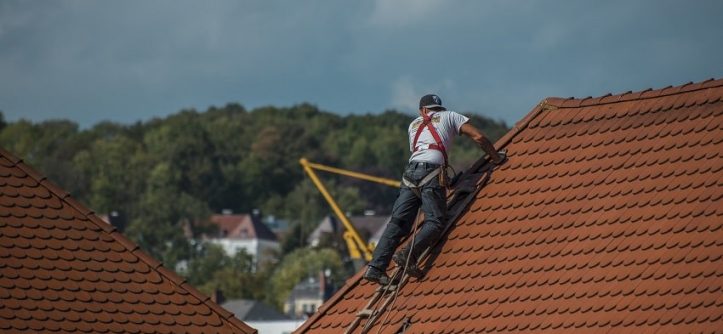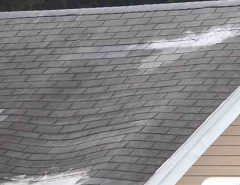Because your roof is one of the most expensive components of your home’s repair and maintenance, we understand that you want it to last as long as possible. By following the advice in this article, you can get the most out of your current roof and move forward with a new roof knowing how to properly care for and preserve your home’s investment.
So, what are the most common causes of roof leaks in homes? Is it simple to fix them? Is a roof leak a guarantee that you’ll need a new roof right now? Let’s start with the most typical causes of asphalt shingle roof leaks.
Frequent Causes Of Roof Leaks
Your roof will almost definitely leak if shingles are missing. Strong winds or other inclement weather can pull your roof’s shingles off, allowing exposed decking to absorb water and seep into the ceiling below. After a major storm, you should inspect any concealed portions of your roof visually, since there are many areas of your roof where you can’t see the shingles unless you physically walk around on it. A professional and skilled roofing contractor will have no trouble going up to inspect your shingles.
Your roof will leak if there is debris on it. Water can be trapped behind excess or built-up debris on your roof, causing it to seep into the shingles and underlayment by capillary action. It’s important to keep your roof clean.
Excess moisture leaking from one region of your roof to another will almost surely cause your roof to leak. If your higher roof gutters discharge straight onto your lower roof, your roof will get oversaturated, resulting in a roof leak from your lower roof. Redirect all downspouts and gutter systems to a spot where moisture will not run onto your roof, regardless of whatever part of the roof they are on.

Roof leaks are often created by the installation and removal of ornaments. If you remove the hardware from a satellite dish or weather vane and leave the holes unpatched, you’ll almost certainly have a roof leak (you can find more information on the proper removal of roof ornaments here). Any holes left behind after removing a roof ornament should be sealed right away so they don’t collect water and create a roof leak.
Temperature variations, harsh weather patterns, and continuous direct sunshine can prematurely age your roofing material and create leaks over time. Asphalt shingle roofs are renowned for granules falling into gutters and shingles splitting as they age and become brittle. In addition, intense sunshine will melt the tar used to bind your shingles together, reducing the seal’s efficacy.
When it comes to triggering a roof leak, roof vents are one of the most common offenders. To avoid leaks, all roof penetrations must be securely sealed. Gaskets surrounding vents and pipes should be checked for gaps or cracks in the material due to wear and tear. Inspect the shingles surrounding the plastic vent covers for missing nails. In addition, after years of exposure, the plastic vents will fracture, allowing water to enter.
Roof leaks can be caused by the slope of your roof. If your roof slope is too shallow, the wind might raise the shingles, causing the rain to fall beneath them. The International Building Code specifies the minimal slope that can be used.
Your roof may leak due to the metal roof flashing. Roof transitions are sealed with metal roof flashing, and if water rushes down into the region where the flashing should be covered and discovers a gap, it will infiltrate your roof. Metal roof flashing is used on the margins of skylights, where the roof meets the dormer, and where the chimney penetrates the roof. If nails are missing, flashing can slip out of position, and the caulk surrounding the roof flashing dries up and cracks and shrinks over time. Roof leaks near the roof flashing might be caused by one of these conditions.
Roof leaks on the ridge cap are fairly prevalent. Because a ridge cap is supposed to hide the space between the slopes at the roof’s top, this is the case. The ridge top must be properly safeguarded during rope and harness roof construction. If it isn’t, holes in the roofing material might readily form, resulting in a leaky roof.
What Are the Signs That Your Roof Is Leaking?
Many individuals believe that if their roof is leaking, they would scatter pots and pans throughout the house, attempting in vain to catch the water droplets before they strike the carpet. However, it isn’t how the bulk of roof leaks appear.
There are a number of additional signs that your roof is leaking that you’ll be able to detect before your pots and pans become rain barrels. The following list might assist you in recognizing some of the warning signs of a leaking or damaged roof that need repair.
A lack of attic ventilation is a strong indicator that your roof may leak. The reason for this is that without sufficient attic ventilation, heated air becomes trapped. As a result of the heat, the shingles almost bake, causing them to be damaged in a much shorter period of time than the roof lifespan should be.
Once the shingles have been baked and damaged, it will only be a matter of time until water seeps through the roofing material and soaks into the roof decking. Curling shingles are an indication that you’re on the verge of a roof leak. Water absorption or trapped hot air in the attic can also produce these problems. You will no longer have efficient water protection in those locations if your shingles have curled.
Buckling shingles are another sign that you’ll have to deal with a roof leak sooner rather than later. Buckling shingles can be caused by a poor felt application during roof installation or by movement or shifting in the roof deck after installation.
The loss of shingle granules (example: https://www.owenscorning.com/en-us/roofing/tools) is a sure sign that a roof leak is on the way. When shingles age, the weather wears them down, or they are harmed by loose debris blowing around, the granules fall off. The most obvious signs of granule loss may be found in your gutters. If your gutters are blocked and there are a lot of granules trapped within, you’re losing them quickly and possibly already have water on your roof.
Missing shingles are the most visible indicator that your roof is leaking or will start leaking the next time it rains in your neighborhood. Storms, severe winds, and other weather events can dislodge shingles. It usually happens when shingles aren’t correctly secured down during installation.
If you see roof deterioration, you have an active roof leak. Water absorbs into the roof mat, causing roof rot. Organic roof shingles are the most common source of this problem.
Ceiling or roof water stains are another telltale indicator that you’re dealing with an active roof leak. If you see damp or brown stains on your ceiling or roof decking, your roof is absorbing water, and you’ll need to prepare for a roof replacement.
Algae and mold are both telltale symptoms of a leaky roof, indicating that your roof has been absorbing water for some time. Over time, algae can develop on a roof and it will begin to thrive due to a lack of roof cleaning and upkeep. Mold forms when airborne spores come into touch with moisture in your roof decking and ceiling, and warm and humid circumstances encourage it to flourish.
Finally, if you see any broken flashing, you should immediately contact a roofing contractor. Damaged flashing may occasionally be fixed if it is discovered and addressed in a timely manner. Water infiltration will develop quickly if the flashing is done incorrectly or if drying and cracking occur around the roof extrusions.




